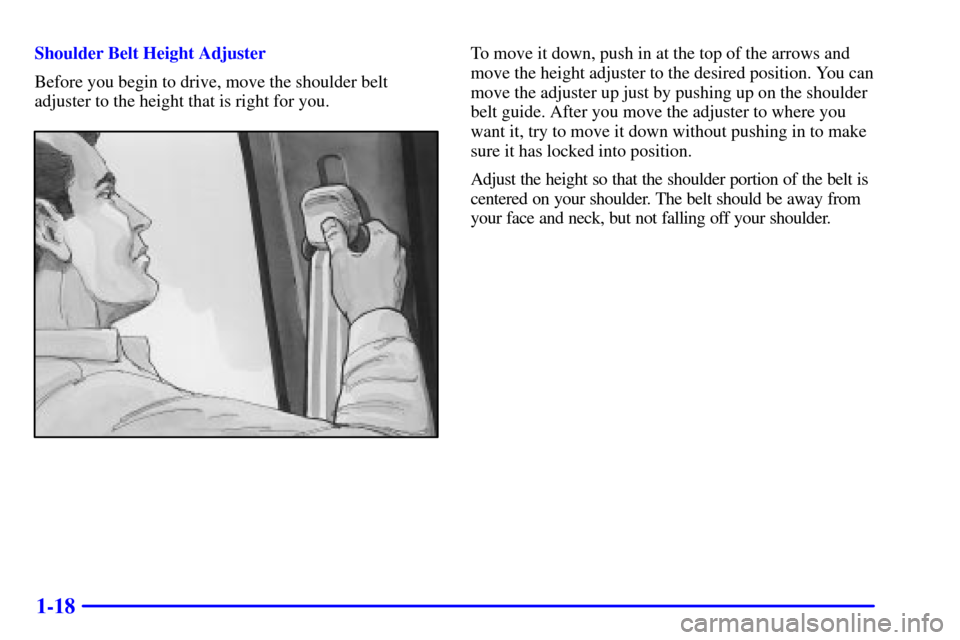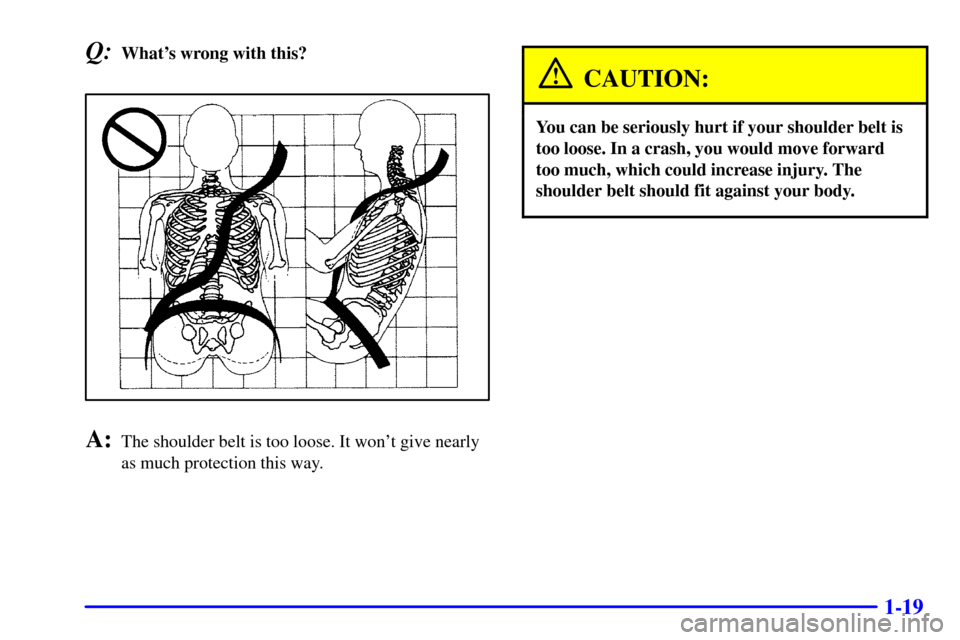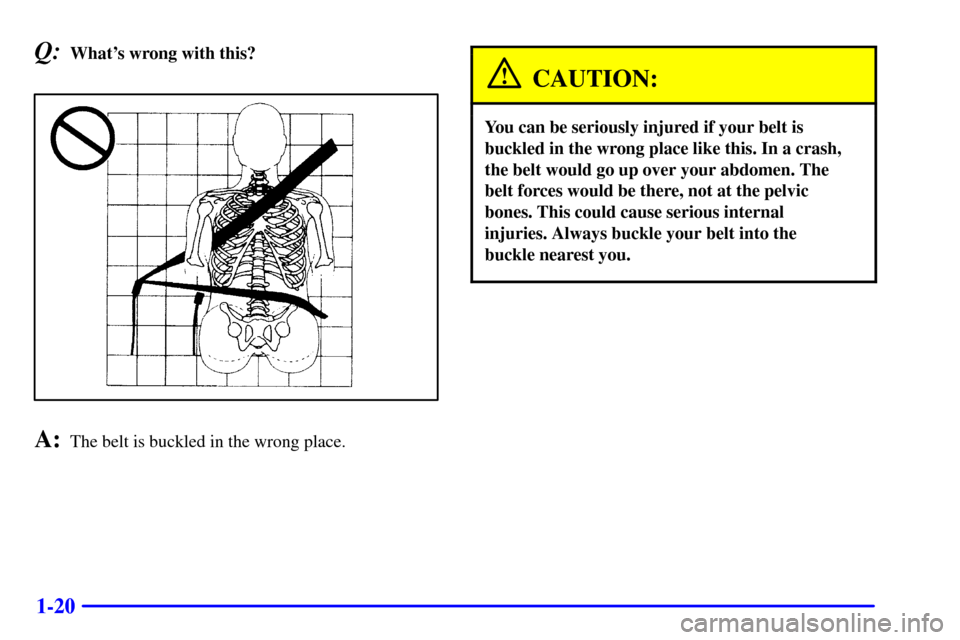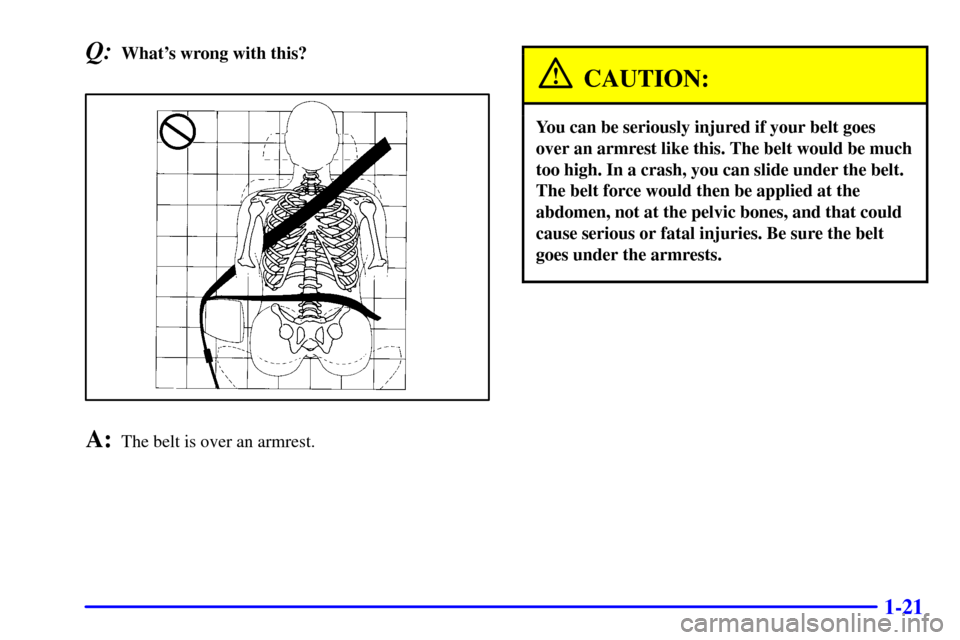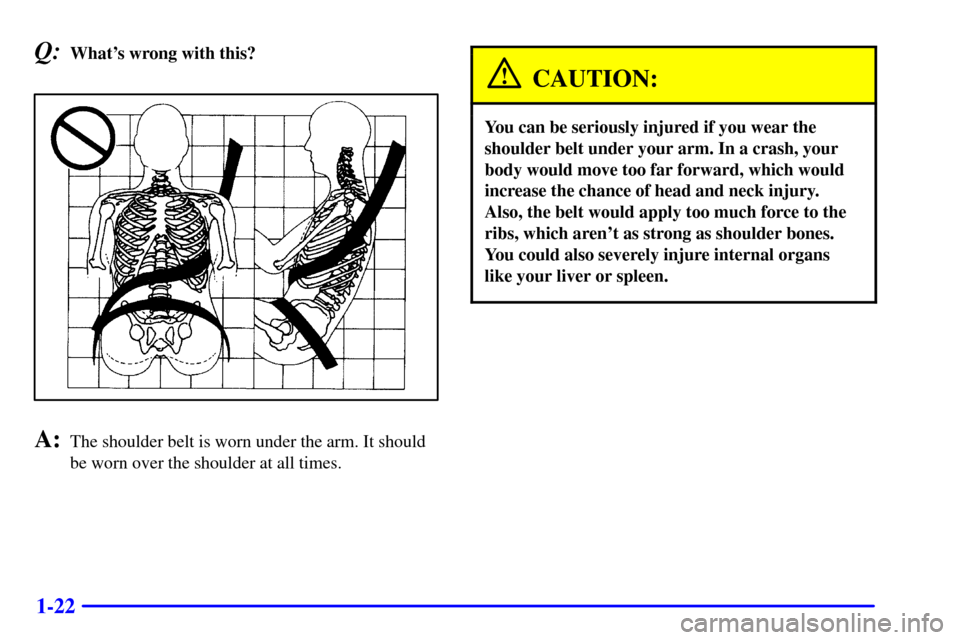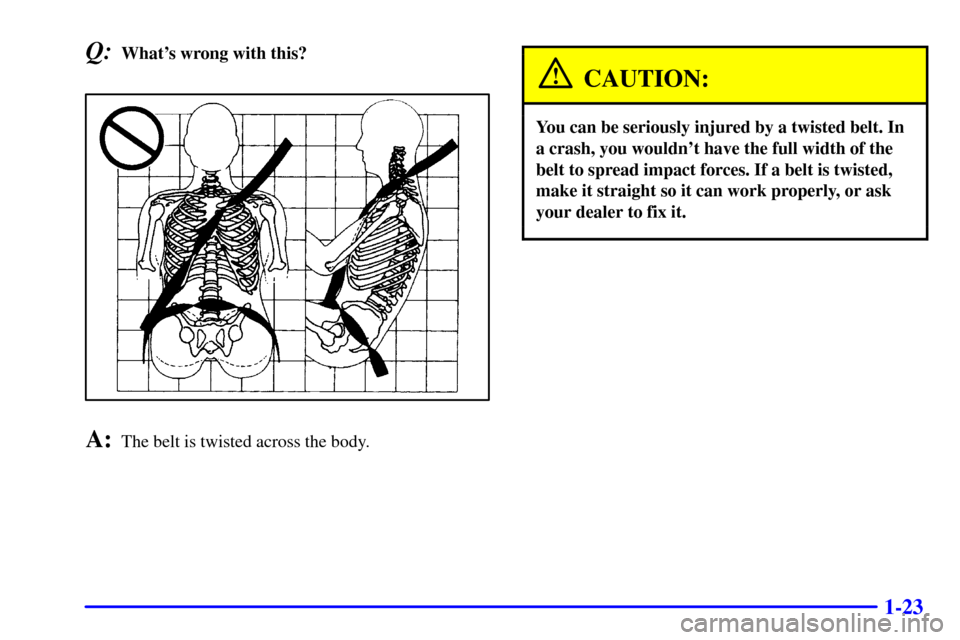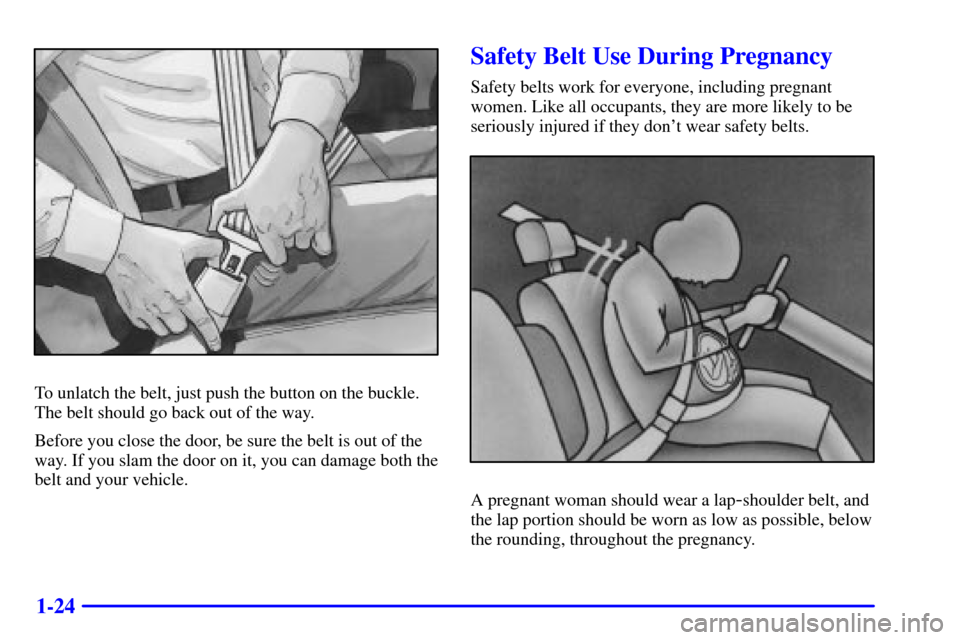CHEVROLET EXPRESS CARGO VAN 2001 1.G Owner's Guide
EXPRESS CARGO VAN 2001 1.G
CHEVROLET
CHEVROLET
https://www.carmanualsonline.info/img/24/8177/w960_8177-0.png
CHEVROLET EXPRESS CARGO VAN 2001 1.G Owner's Guide
Trending: transmission fluid, radiator, battery location, fuel type, AUX, technical specifications, ad blue
Page 31 of 412
1-18
Shoulder Belt Height Adjuster
Before you begin to drive, move the shoulder belt
adjuster to the height that is right for you.To move it down, push in at the top of the arrows and
move the height adjuster to the desired position. You can
move the adjuster up just by pushing up on the shoulder
belt guide. After you move the adjuster to where you
want it, try to move it down without pushing in to make
sure it has locked into position.
Adjust the height so that the shoulder portion of the belt is
centered on your shoulder. The belt should be away from
your face and neck, but not falling off your shoulder.
Page 32 of 412
1-19
Q:What's wrong with this?
A:The shoulder belt is too loose. It won't give nearly
as much protection this way.
CAUTION:
You can be seriously hurt if your shoulder belt is
too loose. In a crash, you would move forward
too much, which could increase injury. The
shoulder belt should fit against your body.
Page 33 of 412
1-20
Q:What's wrong with this?
A:The belt is buckled in the wrong place.
CAUTION:
You can be seriously injured if your belt is
buckled in the wrong place like this. In a crash,
the belt would go up over your abdomen. The
belt forces would be there, not at the pelvic
bones. This could cause serious internal
injuries. Always buckle your belt into the
buckle nearest you.
Page 34 of 412
1-21
Q:What's wrong with this?
A:The belt is over an armrest.
CAUTION:
You can be seriously injured if your belt goes
over an armrest like this. The belt would be much
too high. In a crash, you can slide under the belt.
The belt force would then be applied at the
abdomen, not at the pelvic bones, and that could
cause serious or fatal injuries. Be sure the belt
goes under the armrests.
Page 35 of 412
1-22
Q:What's wrong with this?
A:The shoulder belt is worn under the arm. It should
be worn over the shoulder at all times.
CAUTION:
You can be seriously injured if you wear the
shoulder belt under your arm. In a crash, your
body would move too far forward, which would
increase the chance of head and neck injury.
Also, the belt would apply too much force to the
ribs, which aren't as strong as shoulder bones.
You could also severely injure internal organs
like your liver or spleen.
Page 36 of 412
1-23
Q:What's wrong with this?
A:The belt is twisted across the body.
CAUTION:
You can be seriously injured by a twisted belt. In
a crash, you wouldn't have the full width of the
belt to spread impact forces. If a belt is twisted,
make it straight so it can work properly, or ask
your dealer to fix it.
Page 37 of 412
1-24
To unlatch the belt, just push the button on the buckle.
The belt should go back out of the way.
Before you close the door, be sure the belt is out of the
way. If you slam the door on it, you can damage both the
belt and your vehicle.
Safety Belt Use During Pregnancy
Safety belts work for everyone, including pregnant
women. Like all occupants, they are more likely to be
seriously injured if they don't wear safety belts.
A pregnant woman should wear a lap-shoulder belt, and
the lap portion should be worn as low as possible, below
the rounding, throughout the pregnancy.
Page 38 of 412
1-25
The best way to protect the fetus is to protect the
mother. When a safety belt is worn properly, it's more
likely that the fetus won't be hurt in a crash. For
pregnant women, as for anyone, the key to making
safety belts effective is wearing them properly.
Right Front Passenger Position
To learn how to wear the right front passenger's
safety belt properly, see ªDriver Positionº earlier
in this section.
The right front passenger's safety belt works the same
way as the driver's safety belt
-- except for one thing.
If you ever pull the shoulder portion of the belt out all
the way, you will engage the child restraint locking
feature. If this happens, just let the belt go back all the
way and start again.
Air Bag System
This part explains the air bag system.
Page 39 of 412
1-26
If it says AIR BAG on the middle part of the steering
wheel and AIR BAG on the instrument panel in front of
the right front passenger's seat, your vehicle has two air
bags
-- one air bag for the driver and another air bag for
the right front passenger.If it says AIR BAG on the middle part of the steering
wheel but it doesn't say AIR BAG on the instrument
panel in front of the right front passenger's seat, your
vehicle has an air bag for the driver only.
If it says AIR BAG on the middle part of the steering
wheel, but there is no right front passenger seat, your
vehicle has an air bag for the driver only.
If it doesn't say AIR BAG on the middle part of the
steering wheel, your vehicle doesn't have air bags.
Frontal air bags are designed to help reduce the risk of
injury from the force of an inflating air bag. But these
air bags must inflate very quickly to do their job and
comply with federal regulations.
Page 40 of 412
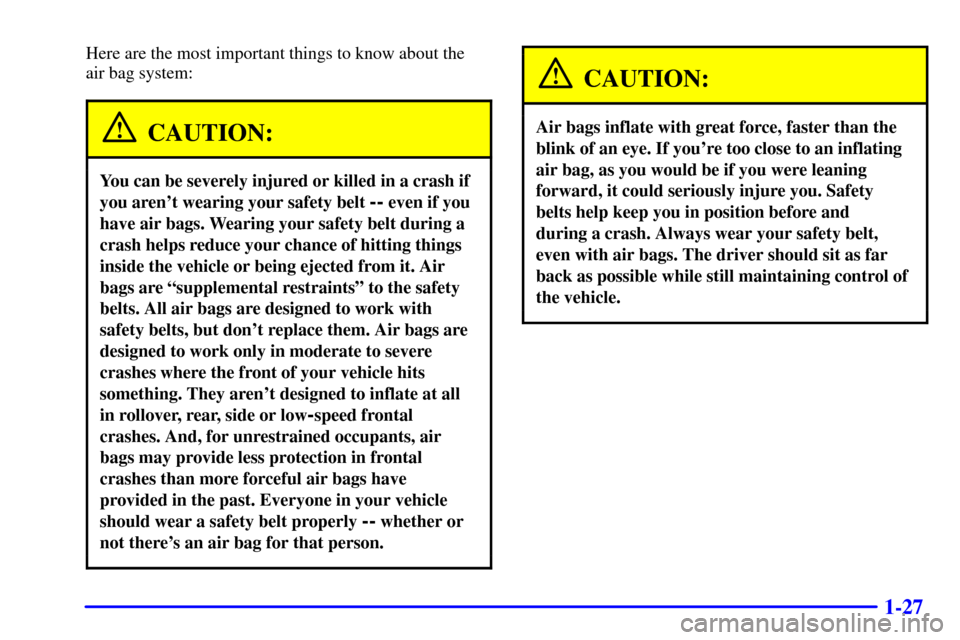
1-27
Here are the most important things to know about the
air bag system:
CAUTION:
You can be severely injured or killed in a crash if
you aren't wearing your safety belt
-- even if you
have air bags. Wearing your safety belt during a
crash helps reduce your chance of hitting things
inside the vehicle or being ejected from it. Air
bags are ªsupplemental restraintsº to the safety
belts. All air bags are designed to work with
safety belts, but don't replace them. Air bags are
designed to work only in moderate to severe
crashes where the front of your vehicle hits
something. They aren't designed to inflate at all
in rollover, rear, side or low
-speed frontal
crashes. And, for unrestrained occupants, air
bags may provide less protection in frontal
crashes than more forceful air bags have
provided in the past. Everyone in your vehicle
should wear a safety belt properly
-- whether or
not there's an air bag for that person.
CAUTION:
Air bags inflate with great force, faster than the
blink of an eye. If you're too close to an inflating
air bag, as you would be if you were leaning
forward, it could seriously injure you. Safety
belts help keep you in position before and
during a crash. Always wear your safety belt,
even with air bags. The driver should sit as far
back as possible while still maintaining control of
the vehicle.
Trending: ignition, fuse box, charging, fuses, manual transmission, fuel tank capacity, snow chains
